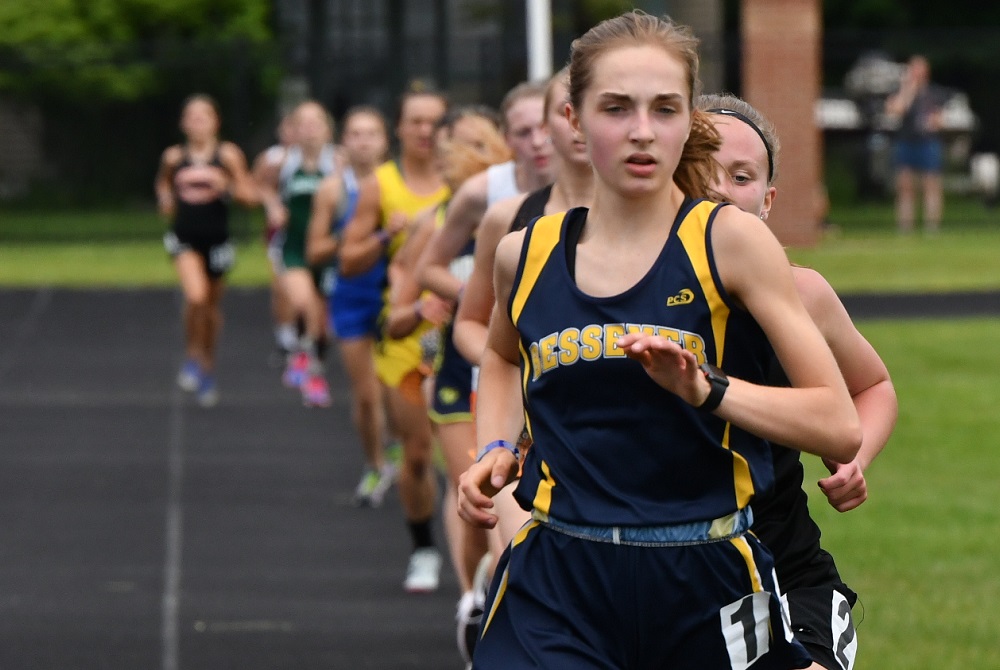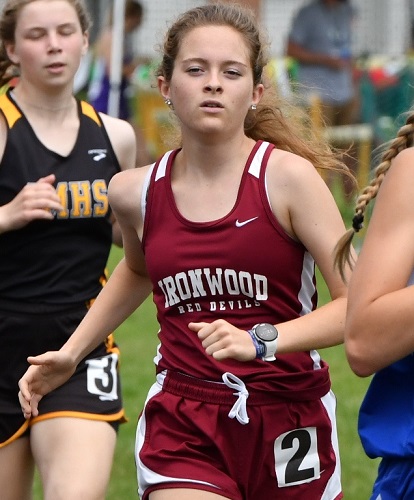
Ironwood's Smith Sisters, Bessemer's Stone Set Fast Pace in Western UP
By
John Vrancic
Special for MHSAA.com
May 9, 2022
IRONWOOD — There are at least three shining stars on the western horizon in Upper Peninsula girls track as Ironwood junior Lilley Smith, her freshman sister Aubrey and Bessemer junior Natalie Stone are setting the pace among distance runners on the Gogebic Range.
 Aubrey Smith won the 1600-meter run at 6 minutes, 0.5 seconds in last Monday’s Jack Kraemer Invitational on a cloudy and chilly day at Longyear Field.
Aubrey Smith won the 1600-meter run at 6 minutes, 0.5 seconds in last Monday’s Jack Kraemer Invitational on a cloudy and chilly day at Longyear Field.
Stone, who had been dealing with leg issues, was runner-up at 6:11.47, and Lilley Smith took fourth (6:14.03), just 34 hundredths of a second behind senior Olivia Soltero of Washburn-Port Wing South Shore (Wis.).
Lilley then dominated the 3,200 at 13:34.16, nearly two minutes ahead of the field.
“In distance running we’re competitive, yet everybody is friendly,” said Lilley Smith. “You gain respect for yourself and others.
“Aubrey has an amazing kick. We started real early. I started in seventh grade and fell in love with it.”
Aubrey Smith was in sixth grade when she began her running career.
“Our mom ran marathons and told us great stories about running,” she said. “When you’re done with a race, you look back at what you did and you’re proud of what you accomplished.”
 Stone also ran in the 1,600 relay in which the Speedgirls took fifth.
Stone also ran in the 1,600 relay in which the Speedgirls took fifth.
“Everything is very tight,” she said. “I felt good today, but I’m still a little sore. I’m just so happy to be able to run because I love it so much. Running is a lifetime sport, and I want to do it all my life. I had missed six weeks. This is only my second day back, and my lungs aren’t quite there yet.”
Last fall, Aubrey Smith was runner-up and Lilley placed sixth at the Upper Peninsula Division 2 Cross Country Final at Marquette. Smith was third in the 1,600 and second in the 3,200 at last spring’s UPD2 Track & Field Finals.
“Aubrey is very talented and hard working,” said Ironwood cross country coach Ben Schmandt. “It’s challenging for a freshman to compete at the highest level. Lilley is also one of the hardest workers on the team. She exemplifies perseverance. She fell down at Hancock and was the first one to finish (fourth overall in cross country) with bleeding feet. That’s dedication in the truest form. She’s one of the most coachable kids we’ve had.”
Stone placed third at the UPD2 Cross Country Final and in the 1,600 in UPD3 last spring at Kingsford behind Mid Peninsula’s Landry Koski and Rudyard’s Tristan Smith.
“Lilley and Aubrey push me, and I push them,” said Stone. “It’s so much fun to run with them. Hopefully, the U.P. Track Finals will go better for me this year. Landry is a very good runner. She just came from behind and won it. She has a real strong kick.”
Bessemer coach Tracy Rowe refers to Stone as one of the team’s leaders.
“Natalie is a great runner,” she said. “You feel so bad for kids when they get hurt. I’m just glad she can run and feels better.”
At Friday’s Ontonagon Invitational, Aubrey Smith placed fourth (6:10.8) and Lilley was fifth (6:11.2) in the 1,600. Lilley then took second in the 3,200 (13:10.3).
“We enjoy running with each other,” Aubrey said after the meet in Ironwood “We give each other the thumbs up when we pass each other in a race.”
“I love Natalie,” Smith added. “I’ve been running against her since middle school.”
 John Vrancic has covered high school sports in the Upper Peninsula since joining the Escanaba Daily Press staff in 1985. He is known most prominently across the peninsula for his extensive coverage of cross country and track & field that frequently appears in newspapers from the Wisconsin border to Lake Huron. He received the James Trethewey Award for Distinguished Service in 2015 from the Upper Peninsula Sportswriters and Sportscasters Association.
John Vrancic has covered high school sports in the Upper Peninsula since joining the Escanaba Daily Press staff in 1985. He is known most prominently across the peninsula for his extensive coverage of cross country and track & field that frequently appears in newspapers from the Wisconsin border to Lake Huron. He received the James Trethewey Award for Distinguished Service in 2015 from the Upper Peninsula Sportswriters and Sportscasters Association.
PHOTOS: Bessemer’s Natalie Stone leads a race during last season’s UPD3 Finals at Kingsford. (Middle) Ironwood’s Lilley Smith is among those pacing the pack during last season’s UPD2 Final in the 1,600. (Photos by Cara Kamps.)

Track Gaining Speed Toward Future with Electronic Starting Devices
By
Steve Vedder
Special for MHSAA.com
May 23, 2023
Aubrey Greenfield thinks it might be the perfect time to reevaluate 130 years of tradition.
For a number of reasons, from technical to personal, the Oxford senior sprinter believes it makes sense for the crack of a starting pistol to be eliminated from high school track meets.
Because track meets would benefit in various ways from lowering costs to easier setup at meets to the human factor of competitors not having to flinch at the crack of a pistol shot, Greenfield believes the sport has a chance to embrace new technology – electronic starting devices (ESD).
In essence, an ESD replaces the starting pistol with a light flash, tone sound or both to begin a race.
"High school sports should put the athlete first," Greenfield said. "We should promote sports, and eliminating starting pistols promotes health in terms of PTSD or trauma for athletes and spectators and that would be good. I would like to think people would say that's a good idea."
In fact, Greenfield would go as far as to say if there was not an implementation of electronic starting devices, many of her teammates would have considered giving up the sport.
"If it's something that helps us compete safely, we're all for it," she said.
Greenfield's opinion apparently is spreading. Michigan High School Athletic Association senior assistant director Cody Inglis said the use of ESD makes it both affordable for meet starters and sensible for athletes and fans to rethink the use of starting pistols. While the MHSAA is not mandating electronic starting devices, it does promote the use of what Inglis calls "emerging technology." He notes that ESD are becoming the norm for organizations such as USA Track & Field, the NCAA and an increasing number of high schools.
 "I think we have to embrace new technology, and we think this will be something that takes hold," Inglis said.
"I think we have to embrace new technology, and we think this will be something that takes hold," Inglis said.
A key part of embracing ESD is the human element. The tragic Oxford High School shooting Nov. 30, 2021, that took the lives of four students while injuring seven others should not be relived even for a fleeting instance at a high school sporting event. Oxford athletic director Tony DeMare said the school began using ESD at every meet, including the MHSAA Lower Peninsula Division 1 Finals last June. He said that decision was embraced by virtually all schools Oxford encountered.
"We were very convinced that the alternative (of ESD) would promote a healthy attitude," DeMare said. "We were overwhelmed with the positive response. If a school was on the fence about it or might not be for it, I think we've started to see the tide turn in favor of people willing to listen and learn about electronic starting devices."
Inglis said the MHSAA is acutely aware of what the crack of a starting pistol can mean to athletes and fans.
"It's unimaginable what Oxford went through, and this is a small way we can help," he said. "We look at a (starting pistol) and think, ‘Could we do something else?’ It's a way of helping to solve a problem."
Over the last several years, the MHSAA has embraced finding an alternative to starting pistols. Inglis noted the discussion started with the cost and diminishing availability of 32-caliber ammunition that meet starters use. A box of ammunition, if it can be found, is around $75 a box.
In addition to cost, there is potential damage from excessive exposure to 150-plus decibels of sound generated by the traditional 32-caliber blanks. Medical studies show damage to ears caused by decibel levels above 120 dB.
The tragedy at Oxford accelerated the conversation.
Inglis said the cost of ESD can be likened to a school sinking money into artificial surfaces at football fields. Yes, there is a great cost at first, but over time money is ultimately saved. An ESD system itself ranges between $200 and $500. Speakers also may need to be purchased, but with ESD starting events like the 800 and 1,600-meter relays positioned near the outside lanes 8, 7, 6 and 5 would result in improved hearing by athletes at the start of a race.
There is one challenge with ESD that track administrators are working to overcome – lighting conditions that lessen the ability to see the ESD’s LED light or strobe when the button is pressed by a starter to begin a race. But that vision difficulty resulting from clear blue skies and backgrounds of setting suns can be substantially improved by incorporating a black background with an ESD – something as simple as a starter holding up black cardboard behind the lighting mechanism at the start of an event.
Inglis said when all factors are considered, the use of ESD makes sense.
 "With the climate we live in nowadays, no lookalike guns is good," he said. "We're not mandating this. But people are saying this is affordable."
"With the climate we live in nowadays, no lookalike guns is good," he said. "We're not mandating this. But people are saying this is affordable."
While switching to ESD would break 130 years of tradition, the timing could be a step forward, said Jeff Hollobaugh, co-author of the book "The Fleet Feet of Spring: Michigan's High School State Championships in Track & Field." He said while no definitive answer is possible, it's likely starting pistols were used at the inaugural state meet at the Jackson Fairgounds in 1895. The meet, which included events like tossing a 16-pound shot put, bike races and a 100-meter sprint, was sponsored by the Michigan Interscholastic Athletic Association (a predecessor to the MHSAA) and comprised mostly of the state's larger schools.
Hollobaugh's sentiments echo what many involved in today's high school track & field believe in terms of making a transition from starting pistols to electronic starting devices.
"It's a change, not necessarily good or bad, just different," he said. "It's not a drastic change, but it will take some getting used to. But it is the future. In the end, we'll all be fine."
DeMare believes the future of high school track will definitely include ESD.
"Our desire is that the practicality and sensibility of this will overcome the alternative," he said. "I think we'll see the automation and electronics taking hold of certain elements in track, and people will embrace it."
PHOTOS (Top) Runners watch official Bertha Smiley as they prepare to begin a race during last season's Lower Peninsula Division 1 Finals at Rockford. (Middle) An electronic starting device provided by VS Athletics was used to start those races. (Below) Smiley sets to begin an event. (Photos provided by David Kuderka/VS Athletics.)

